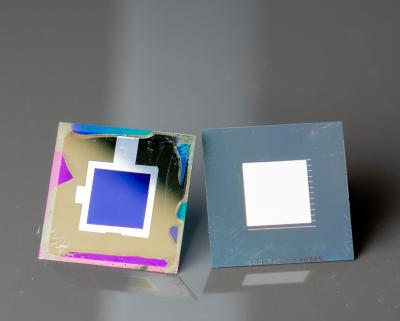Three HZB teams, led by Prof. Christiane Becker, Prof. Bernd Stannowski and Prof. Steve Albrecht, have jointly managed to bring the efficiency of perovskite silicon tandem solar cells to a new record value of 29.80%. This result has been officially certified by Fraunhofer ISE CalLab and is documented in the NREL-charts.
 The perovskite silicon tandem cell is based on two innovations: A nanotextured front side ( left) and a back side with dielectric reflector (right). © Alexandros Cruz /HZB
The perovskite silicon tandem cell is based on two innovations: A nanotextured front side ( left) and a back side with dielectric reflector (right). © Alexandros Cruz /HZB
Several HZB groups have been working intensively since 2015 on both the perovskite semiconductors and silicon technologies and the combination of both into innovative tandem solar cells. In January 2020, HZB had achieved a record 29.15 % for a perovskite silicon tandem solar cell. Then, also in 2020, the company Oxford PV was able to announce a certified efficiency of 29.52%. Since then, the race for new records has been on. "An efficiency of 30% is like a psychological threshold for this fascinating new technology which could revolutionize the photovoltaic industry in the near future," explains Steve Albrecht, who is working on perovskite thin films at the HySPRINT lab at HZB. Bernd Stannowski, group leader for silicon technology, adds: "I would particularly emphasize the good cooperation between the different groups and institutes at HZB. This is how we managed to develop these new tandem solar cells entirely at HZB and once again get the world record."
The recent research and development focus was on the optical improvement of the silicon heterojunction bottom cell. A nanotextured front side and a dielectric back reflector were added. Then came the official confirmation by Fraunhofer ISE CalLab: "Our new perovskite silicon tandem solar cells were independently certified with a world record efficiency of 29.80 %," says Christiane Becker, an expert on nanostructures in solar cells and their effects on the optical and electrical properties.
For the new work, Dr. Philipp Tockhorn (Albrecht group) and doctoral student Johannes Sutter (Becker group) investigated how nanostructures at different interfaces affect the performance of a tandem solar cell, consisting of a perovskite solar cell on top of a silicon solar cell. First, they used a computer simulation to calculate the photocurrent density in the perovskite and silicon subcells for different geometries with and without nanotextures. Then they produced perovskite silicon tandem solar cells with different textures: "Even the nanotexturing on one side improves the light absorption and enables a higher photocurrent compared to a flat reference," says Sutter. And his colleague Tockhorn adds: "Remarkably, the nanotextures also lead to a slight improvement in the electronic quality of the tandem solar cell and to better film formation of the perovskite layers."
Improvements were also made to the back side of the tandem solar cell, which is designed to reflect infrared light back into the silicon absorber. "By using a dielectric reflector, we were able to use this part of the sunlight more efficiently, resulting in a higher photocurrent," says Dr. Alexandros Cruz Bournazou (Stannowski group).
The results pave the way for further improvements. The simulations suggest that the performance could be increased even further by nanostructuring the absorber layers on both sides. The researchers are convinced that an efficiency of well over 30% could be achievable soon.



